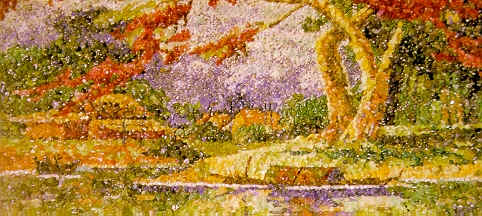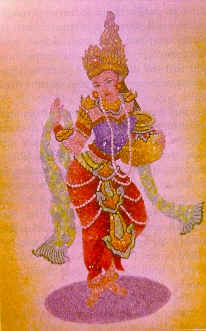
Myanmar Mosaic Art
By Tin Win - Katha (Mann Tetkatho)
Myanmar Perspectives
Vol: VI 1/2001

Myanmar mosaic art was off to a good start by the time of the Bagan period, as scholars and researchers, now testify. Historians also agree.
This noble art is seen mainly on royal and religious items and buildings. But sometimes mosaic is also used in artifacts and household objects of the common lay people to achieve a new sense of beauty and splendor
In this art there are four main disciplines on which the workmanship is based. The four types are Knut (flower style), Kapi (monkey shape), gaza (elephant base) and nari (femininity). These four basics also apply to Myanmar painting and drawing. The materials have shining glorious colors mostly embedded with various precious gems and stones. The glass is lit with colorful, shining objects in mosaic art. Valuable precious gems and semi-precious stones are used to invest ordinary utensils and other household articles with glory and splendor to make them unique and attractive and thus fit for royal use. So they are bedecked with pearls, coals, jade, rubies, etc. The Nine Noble Gems also decorate several items for royal use. Remarkable beauty is thereby achieved. These items decorated with mosaic were used only by royalty and persons of great wealth.
When brilliant gems and fine stones are put on glass by means of starches from the barks of certain trees, in various styles and designs, this art reaches a high state of workmanship. Light, splendor and brilliance is achieved to bedazzle the eyes of all on-lookers.
Glory is also attained. So Myanmar mosaic is also termed the "art of systematic order on glass" (hman-si-shwe-sha) with gold for further embellishment. This is a subtle art to be practiced only by the most skilled specialists.
Experts make the glass that is to be embossed or embedded in various sizes and shapes in the forms of circles, squares, triangles, ovals, etc. according to the dictates of harmony and artistry. Even valuable gems and pearls are embossed or embroidered or bedecked in suitable ways.
In this fine art lacquer starch, is the main essential ingredient to give it a permanent final shape. This essence or substance (glue) is called "thit-say" in Myanmar. It has many different colors and tinges, such as green, black, red-green (all three main colors of "thit-say"). The starch is very sticky and heavy and is a good and effective glue so that the components of the mosaic remain in place for a long time.
The "thit-say" is usually mixed with ashes of cow-bone burnt by fire. This is a process that requires the highest standard of skill. Finally what is called "the-yo" that is the mixed "thit-say" glue is obtained. Sometimes ordinary ashes softened from husks (saw dust) are mixed with thit-say (sap). But the best mixture is charcoal ashes produced from "Mayo" seeds because this results in a very soft and smooth substance for the purpose of fashioning mosaic. When the "tha-yo" is fashioned into strands of rope the resulting effect is in the form of soft candles, with the greatest of smoothness.
After the ash and "thit-say" are mixed thoroughly, the "tha-yo" that is produced is like very thin fine strings, which can be used as thread for embroidery. To get the best "tha-yo" the materials used must be totally free from dust, dirt, stones etc.
The procedure of making the best "thit-say" includes half of the fine "thit-say" substance (essence/juice) of half a tin which is equivalent to 10 viss. This "thit-say" is cooked with suitable heat with great care and method. If the method is wrong and care is not taken, the "thit-say" strings may break during boiling and the mixture may emit a foul. So a person should remain at a distance to avoid the very foul loathsome smells. Without using the right method of boiling, the outcome will be failure and the strings shredded and useless.
A worker should cleanse his or her hands thoroughly with fully cooked rice-water in order to cleanse the stickiness. When "tha-yos" become subtle and soft a little pounding by hand is necessary in order to make them pliable for handling.
These "tha-yo" must be made into small marble like balls by rolling it on a rock. When tiny rolls or strings appear, they are called "coils of tha-yo" or "tha-yo coils" in proportionate sizes in bright colors.
Non-glass mosaic work needs materials of beaten crystal, rope-spreadings and crystal spreadings. There are technical terms with clear meaning for expert-workers in Myanmar.
Techniques are handed down from father to son and there are technical works such as "Kanutta embroidary", embossed with the correct use of pearls, precious gems, multi-colored glasses in wonderful shapes and hues.
However linking and placing of glass and gems etc. are not so difficult like the artistic work of "spreading stings" or "spreading crystals". Yet great attention must be given and each step has to be taken with an artistic eye. For artistic harmony "give and take" is essential. The artistic worker must fully known his or her particular art to put things in the right places when the work of "spreading strings" starts. The choice and exactness of placement are essential for correct design and style.
These artist and experts in the fields of "kyo-kin spread", or "flower spread" placement of valuable gems, polishing etc., make their best endeavor for the sake of artistic harmony and proper arrangement.
Finally the finished products and items look wonderful and unique. The weights especially must be in harmony. So persons who see Myanmar mosaic works feel intense joy and high appreciation.
If gold gilding is necessary, quicksilver is mixed with "thit-say" pulp. Then only gilding work is dine with success. Sometimes thin gold leaves must be put on with black "thit-say" as base. In the days of Myanmar kings this fine mosaic art belonged to the sphere of royalty to be preserved by Department of Royal Treasures.
Indeed this subtle work of art has many related artistic disciplines so that the Myanmar kings used to give high rewards and titles to these artists. Therefore in the modern age, artists should strive to preserve these fine old artistic works. Mosaic art should not disappear. Myanmar's cultural heritage must be continued and preserved well. This is my hope.
